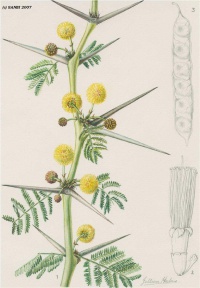Acacia xanthophloea
Contents
General Plant Info
Geographic distribution
Distribution: Native to southern and eastern Africa, including Botswana, Kenya, Malawi, Mozambique, Somalia, South Africa, Swaziland, Tanzania, Zambia and Zimbabwe. Naturalized in the USA and 3 trees are growing in S.E. Queensland, Australia.
Habitat: This species is found in low-lying areas in association with water. It grows in swampy areas, on the margins of lakes and pans and along river banks. It often forms dominant stands in seasonally flooded areas in alluvial soils[1]
Identification
Bark: The main stem of mature trees is smooth, with occasional irregular depressions and flaking, and is characteristically lime-green to greenish-yellow. Scars due to broken branches or other injuries are dark brown to black[2]
Spines: Straight, hairless and occur in pairs at nodes. Average length 40-85mm depending on age of tree[3]
Flowers: Globose flowering heads are borne at the nodes, mainly on previous seasons' shoots. They are bright yellow and 10-14mm in diameter[4]
Seed pods: The indehiscent pods are straight and hairless, and often have marked constrictions between seeds. Young pods are green while dry pods are dark brown, breaking up transversely into segments after being shed. They attain a length of 30-75mm and a width of 7-14mm. Seeds are elliptic[5]
Alkaloid content
Our preliminary phytochemical analysis revealed the presence of anthraquinones, flavonoids, saponins, terpenoids and other alkaloids[6]
The bark contains 17% condensed tannins[7]
Extraction
Other uses
Cultivation
Suppliers
Links
References
nen888 2012, Trying to improve Acacia information - Acacia xanthophloea. Available: [1] [2014, 04/12].
Nundkumar, N. & Ojewole, J.A.O. 2002, "Studies on the antiplasmodial properties of some South African medicinal plants used as antimalarial remedies in Zulu folk medicine", Methods and findings in experimental and clinical pharmacology, vol. 24, no. 7, pp. 397-402.
Smit, N. 2008, Field Guide to the Acacias of South Africa, Briza Publications, Pretoria.
